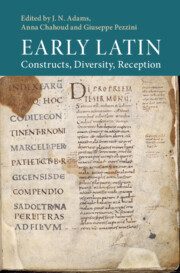Book contents
- Early Latin
- Early Latin
- Copyright page
- Dedication
- Contents
- Illustrations
- Tables
- Contributors
- Acknowledgements
- Abbreviations
- Chapter 1 Introduction: What Is ‘Early Latin’?
- Part I The Epigraphic Material
- Part II Drama
- Part III Other Genres and Fragmentary Authors
- Part IV Reception
- Bibliography
- Index Verborum
- Index of Non-Latin Words
- Index Locorum Potiorum
- Subject Index
Chapter 1 - Introduction: What Is ‘Early Latin’?
Published online by Cambridge University Press: 27 July 2023
- Early Latin
- Early Latin
- Copyright page
- Dedication
- Contents
- Illustrations
- Tables
- Contributors
- Acknowledgements
- Abbreviations
- Chapter 1 Introduction: What Is ‘Early Latin’?
- Part I The Epigraphic Material
- Part II Drama
- Part III Other Genres and Fragmentary Authors
- Part IV Reception
- Bibliography
- Index Verborum
- Index of Non-Latin Words
- Index Locorum Potiorum
- Subject Index
Summary
What is ‘early Latin’? The main contention of the present volume is that this question does not have a single answer. Rather, ‘early Latin’ is one of those ubiquitous labels (like ‘old’ or ‘archaic’ Latin) which have been used by classical scholars to denote different linguistic entities, and above all to describe a variety of linguistic features, in an often confusing and potentially contentious way. ‘Early Latin’ is above all a linguistic construct, which evokes frameworks of periodisation (often diverging), and posits a distinction between a supposedly discrete and cohesive linguistic variety (‘classical Latin’) and another one, equally discrete and cohesive, belonging to an earlier time period (‘pre-classical Latin’, a notion which has often carried negative value judgments since antiquity). Far from aiming to replace one theoretical framework with another, the studies presented here contribute, through a fresh analysis of specific linguistic phenomena and stylistic trends, to challenge the myths of periodisation and standardisation, and to expose the limited usefulness of evolutionary models to explain language change.
- Type
- Chapter
- Information
- Early LatinConstructs, Diversity, Reception, pp. 1 - 12Publisher: Cambridge University PressPrint publication year: 2023

